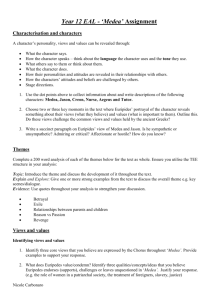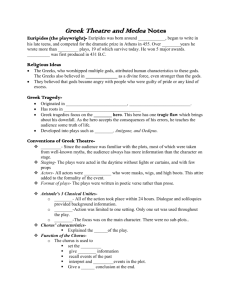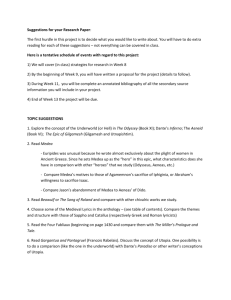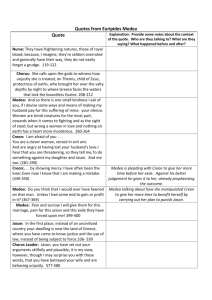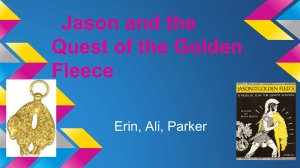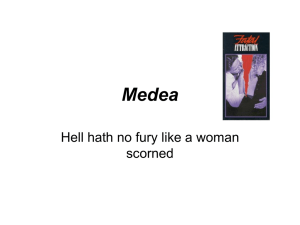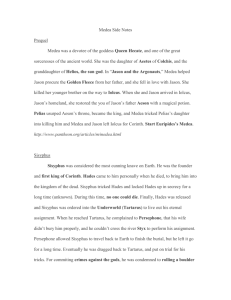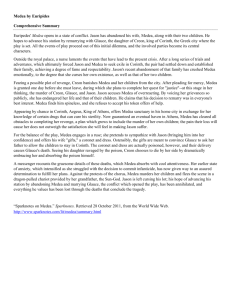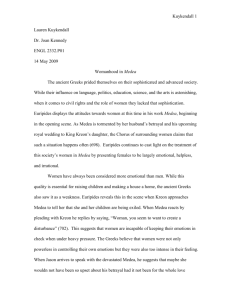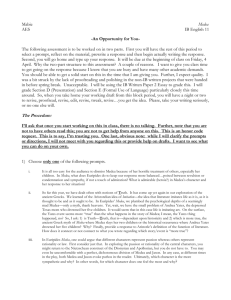medea-packet1 - College of Fine Arts
advertisement
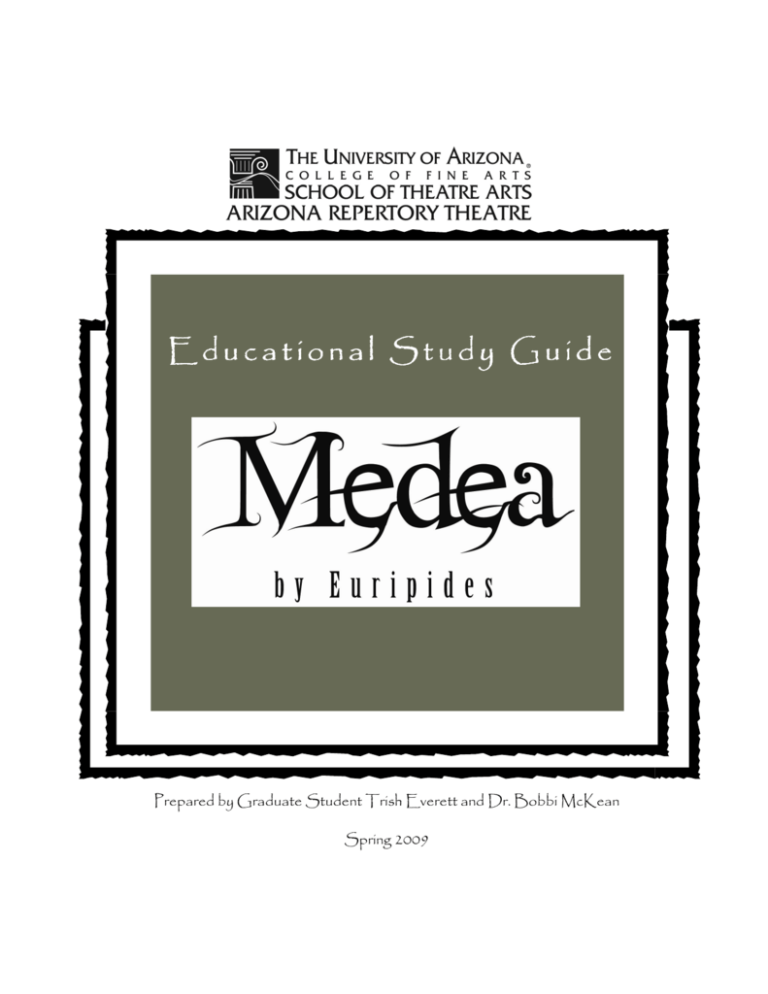
Educational Study Guide Prepared by Graduate Student Trish Everett and Dr. Bobbi McKean Spring 2009 Introduction Welcome to the study guide for the Arizona Repertory Theatre’s (ART) productions of Medea by Euripides. ART is an educational and professional training company based in the UA School of Theatre Arts. The school provides academic and professional training to undergraduates and graduates. Classroom study, research, studio/laboratory training and production serve the students in their degree pursuit. The school is committed to the highest academic standards and performance excellence. Because of its classical orientation and style work, Medea was selected to serve the training needs of the students in the ART company. The production serves the school by not only developing professional training skills, but also by providing quality theatre for the student body, faculty and the entire community. This study guide has information and activities that can be done with your students before and after attending the live stage production. Please feel free to make copies for your students and colleagues. Also, please visit our website at http://www.cfa.arizona.edu/theatreartsoutreach/ for even more educational materials and interactive resources for students and teachers! Introduction Page 2 Play Synopsis Page 3 Director’s Concept Page 3 Character Descriptions Page 4-5 Dramaturgical Notes Page 5 Bio of Euripides Page 6 Themes Found in Medea Page 7 Greek Theatre History Page 8 Classroom Activities Page 9-11 References and Credits Page 12 Contact Info Page 12 2 Synopsis The play Medea tells the story of Medea and Jason, two figures well known by ancient Greek audiences. Euripides, knowing the notoriety of these characters, began the play toward the end of their story. At the play’s opening, Medea is an outcast, a foreign exile in Corinth. Medea was the Princess of Colchis. She fell in love with Jason when he went to Colchis in search of the Golden Fleece. Medea used her powers as a sorceress to help Jason gain the Fleece, betraying her father and killing her brother in the bargain. Jason returns to Corinth with Medea and their children; now there, he decides to marry the daughter of King Kreon. As the play begins, Medea’s nurse wishes Medea had never met Jason for she knows that with Medea’s passionate temper, she will not take kindly to Jason’s betrayal. Medea, abandoned and enraged, finds strength in her rage and despair and decides to seek revenge. Kreon, no doubt recognizing that Medea and her children will pose a constant threat to his own line of succession, has ruled that Medea and her children must again be sent into exile. After Medea apologizes to Jason, she is given one more day to prepare to leave, and her sons are permitted to stay in Corinth. Medea sends Jason’s new bride gifts of a golden robe and crown which when worn, cause an excruciating death. Kreon, trying to save his daughter, is killed by Medea’s gifts as well. In a final act of vengeance against Jason, Medea kills both of her children, leaving Jason childless and Corinth in turmoil. Director Brent Gibbs’ Concept Euripides’ Medea is one of the great tragedies in the Greek tradition. This classic tale has persisted for thousands of years since its writing in 431 BCE. As conceived by director Brent Gibbs for ART, it is a play encompassing “the price of betrayal, the madness of jealousy, the passions that overwhelm us, and the lengths to which we will go to gain retribution.” It is also the tale of a onceimmortal woman who gave up her divinity for her beloved. Ultimately, Medea is an investigation of mortality in all its most beautiful and grotesque forms. Gibbs has chosen to set Medea in a remote coastal fishing village during the 1930’s utilizing the distancing effect of history, while maintaining a more modern approach to this classic play and removing it from its traditional confines of time and place in Greece. The cliffs of Moher, Western Ireland, one of the inspirations for the scenic design. 3 Character Descriptions MedeaMedea Protagonist of the play, Medea is the Princess of Colchis, a land considered by the Greeks to be barbarous and wild located on the edge of the black sea. Jason– Jason Jason was once a great adventurer, and now seeks to become King of Corinth. Children-the children of Jason and Medea. Children Kreon, King of CorinthCorinth The King of Corinth and father of Jason’s new bride, Glauce. GlauceGlauce Princess of Corinth, the woman Jason intends marries. She is not actually present onstage in this production. Medea’s NurseNurse The Caretaker of the house and the children, the Nurse’s primary purpose is to convey the back story of Medea and Jason’s history and to foreshadow the tragic ending of the play. Tutor– Tutor A minor character, he is responsible for the education of the children and serves as a messenger, relating events in the play to the other characters and audience. 4 Characters Continued Aegeus, King of AthensAthens The King of Athens who promises Medea protection in his city once she escapes from Corinth. According to the legend, Aegus eventually marries Medea and she bore his son, Medus. MessengerMessenger The messenger appears only once in the play--he relates in gruesome, vivid detail the death scenes of Glauce and Kreon, which occur offstage. The use of messengers relating news of gruesome deaths is quite common in many other Greek tragedies as well. ChorusChorus The chorus in Greek tragedy impersonates a definite group of people. It is physically separated from the central characters but it is always within hearing distance of the central characters. It comments on the meaning and significance of the actions of the characters without interacting with the characters. Notes from the Dramaturges 5 The Playwright Euripides 6 Themes of the Play In Medea’s complex and contradictory Other more general themes include: character Euripides employs at least five Revenge, Power: and Greed: Much of voices which highlight themes in the Medea is concerned with issues of revenge, play. power and/or greed. Jason seeks the Golden 1. Medea as Woman, Woman the feminine both as Fleece to regain his position of power and hopefully the crown, then seeks to marry loyal wife and nurturing mother Glauce to secure Kreon’s seat of power. 2. Medea as Other, Other the barbarian sorcer- Medea seeks revenge for the injustice Jason ess and intruder from an uncivilized land has shown her. 3. Medea as Hero, Hero honor-obsessed, intent Catharsis: Catharsis Endless debates have centered upon action and reputation and fearing laughter by peers on the term "catharsis" which Aristotle unfortunately does not define in The Poetics, his treatise on Tragedy. Some critics inter4. Medea as Athenian, defining herself pubpret catharsis as the purging or cleansing of licly and using the language and rhetoric of pity and fear from the spectators as they obthe law court and assembly serve the action on stage; in this way tragedy relieves them of harmful emotions, leav5. Medea as Theos or God, God as evidenced ing them better people for their experience. in her final epiphany and pronouncements. According to this interpretation, Aristotle may have been offering an alternative to Plato's charge that the dramatic poets were dangerous to society because they incited the passions. Theatre at Delphi, Greece 7 Greek Theatre History “Attending a tragedy or comedy in 5th century BC Athens was in many ways a different experience than attending a play in the United States in the [21st] century. To name a few differences, Greek plays were performed in an outdoor theater, used masks, and were almost always performed by a chorus and three actors (no matter how many speaking characters there were in the play, only three actors were used; the actors would go back stage after playing one character, switch masks and costumes, and reappear as another character). Greek plays were performed as part of religious festivals in honor of the god Dionysus, and unless later revived, were performed only once. Plays were funded by the polis, and always presented in competition with other plays, and were voted either the first, second, or third (last) place. Tragedies almost exclusively dealt with stories from the mythic past (there was no "contemporary" tragedy), comedies almost exclusively with contemporary figures and problems.” (Englert) For more information, see http://academic.reed.edu/humanities/110tech/Theater.html Aristotle’s Poetics and Tragedy Aristotle’s treatise on Tragedy, “The Poetics”, identifies the main elements of tragedy. The best form of tragedy has a plot that is what he calls "complex," it imitates actions arousing horror, fear and pity, and the hero's fortune changes from happiness to misery because of some tragic mistake (hamartia) that he or she makes. The horrific deed may be done consciously and knowingly (Medea), or unknowingly with knowledge following after (Oedipus); or it may be left undone, due to timely discovery, or to full knowledge present at the point of doing the deed. The characters must be good, appropriate, consistent, or consistently inconsistent, he argues. -plot (mythos), -character (ethos), -thought (dianoia), -diction (lexis), -melody (melos), -spectacle (opsis). The key elements of the plot are -reversals (peripeteia), -recognitions (anagnorisis) -suffering (pathos). 8 Classroom Activities Exploring Medea’s Voices Divide class into five groups and assign each group one of the “voices” of Medea found on page 7. Ask each group to create a contemporary scene that highlights that particular aspect of her character. Each scene will have an actor playing Medea and then other characters can be added to support that particular voice depending on the scene your students create. Share each scene with the whole class. ——————————————————————————————————————— Exploring the Themes of Revenge, Power and Greed Have students brainstorm other plays, novels, short stories and films where the central characters are driven by revenge, greed and/or a thirst for power. Why does this theme provide inspiration for so many plots? Why does this theme endure? What purpose do the stories/books/films serve in our modern context? ——————————————————————————————————————— Exploring Catharsis and Aristotle’s Poetics Work as a whole class or in small groups to choose a familiar tragic story, play or movie. Identify Aristotle’s elements of tragedy in this work. Are all of the elements of tragedy there? Are all Aristotle’s elements of plot used? Who is the hero? What is the tragic mistake? Discuss the idea of catharsis. How does the reader or audience respond to the work you’ve chosen? Would you call the modern tragedy chosen cathartic? —————————————————————————————Before and After Discussions Often, directors will place a classic play in a different time and place in order to highlight certain themes or to find the universality. BEFORE THE PLAY, discuss the choice of setting and view the powerpoint of the scenic construction process on our website. (http://www.cfa.arizona.edu/theatreartsoutreach/) What expectations does this sneak peak give you about the play? AFTER THE PLAY, discuss if the production lived up to your expectations? Did the set and director’s concept work to emphasize the themes of Medea? 9 Contemporary Character Analysis Activities What sort of characters are Jason, Medea, Kreon, Glauce and the rest? The following are ideas for students to explore these characters within a contemporary frame of reference. Each could be adapted into a writing assignment of some sort, or be a topic for discussion. • Create a myspace or facebook profile (off line) for the characters. What sort of personal information would they share with others about themselves? • Write an article about Jason and Medea’s relationship as if it were to appear on TMZ or another celebrity/celebutante gossip magazine or site. How would the media portray these people and their relationship? • What might people say about the characters in letters to the editor of a newspaper? • Write and/or perform a news report covering the action of the play or specific parts of the action like the deaths of Medea’s children, Kreon and Glauce. • Put Medea on trial for murder. Form jury, prosecutor, defense, witnesses, etc. and stage the trial. Works Referenced and Credits Brown, Larry A. “Aristotle on Greek Tragedy.” Lipscomb University. Jan 2005. <http:// larryavisbrown.homestead.com/Aristotle_Tragedy.html>. Englert, Walter. “Greek Theatre.” Reed College. <http://academic.reed.edu/humanities/ 110tech/Theater.html>. Photos Courtesy of: http://www.columbia.edu/cu/cam/images/pagepics/Medea.png http://www.goofbutton.com/images/ldd24.jpg http://www.eugenedelacroix.org/the-complete-works.html http://www.firstworldwar.com/photos/graphics/ww_dublin_wrecked_01.jpg http://commons.wikimedia.org/wikiFile:Irish_potato_famine_Bridget_O' Donel.jpg Trish Everett’s original photos, January 2006 Medea Actor’s Packet by Dramaturgs: Laura Farrell-Wortman and Alicia James, U of A 10 Questions? Comments? Ideas? Please feel free to contact us! We would love to get feedback on how we can make our educational materials more useful for students and teachers. Please also visit our website http://www.cfa.arizona.edu/theatreartsoutreach/ for more ideas, essays, resources, powerpoint etc. and our interactive blog. Dr. Bobbi McKean– Bmckean@email.arizona.edu Trish Everett– peverett@email.arizona.edu School of Theatre Arts P.O. Box 210003 1025 N Olive Rd, Drama Bldg, Rm 239 Tucson, AZ 85721-0003 phone: 520.621.7008 fax: 520.621.2412 11
